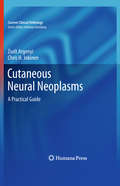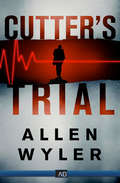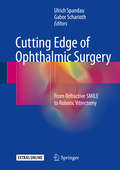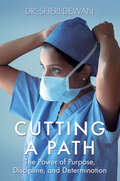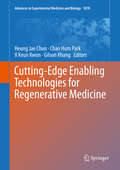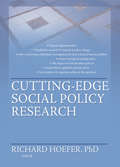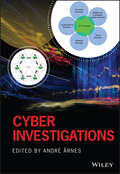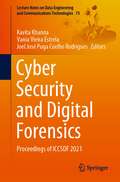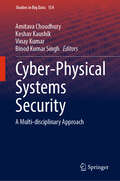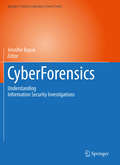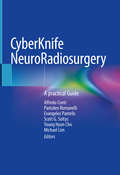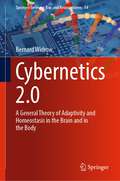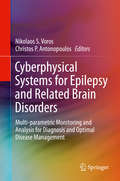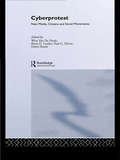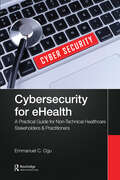- Table View
- List View
Cutaneous Melanoma, Fifth Edition
by John F. Thompson Charles M. Balch Michael B. Atkins Arthur J. Sober Alan N. Houghton Seng-Jaw SoongThe Classic Text—Expanded, Updated...More Authoritative than Ever!Cutaneous Melanoma is the definitive and most authoritative textbook on melanoma used worldwide. This 5th edition provides the most up-to-date and comprehensive information needed for the clinical management and scientific study of melanoma. Written by the leading melanoma experts from the United States, Australia, and Europe, this new edition collectively incorporates the clinical outcomes of more than 60,000 patients treated at major melanoma centers throughout the world.Comprehensive Coverage—from Prevention to Advanced TreatmentThis new edition provides in-depth coverage, ranging from precursors of melanoma to advanced stages of metastatic disease; from melanoma genes to population-based epidemiology; and from prevention of melanoma to all forms of multidisciplinary treatments. Basic principles of diagnosis and pathologic examination are combined with treatment approaches for the many clinical presentations. Clinical management is supported by statistical data about natural history, prognosis, and treatment results. The latest information on staging and prognosis, as well as randomized prospective clinical trials involving surgical treatment and systemic treatments, is included. This volume presents a balanced perspective of the risks and benefits involved in each treatment modality. The book also contains: 1) a comprehensive color atlas of melanoma and its precursors, 2) illustrated surgical and perfusion techniques for every stage and anatomic location of melanoma, and 3) complex genetic and molecular pathways involving melanoma biology. Every drug and biologic agent in use today is described with indications and efficacy.Entirely Revised and UpdatedSeven new chapters discuss the emerging clinical data on the use of biomarkers, adjuvant therapies, targeted therapies, and immune modulation as well as significant clinical research a
Cutaneous Neural Neoplasms: A Practical Guide (Current Clinical Pathology)
by Zsolt Argenyi Chris H. JokinenAs a result to the recent significant developments, both in the field of cutaneous pathology and clinical dermatology, many cutaneous neural tumors are now being diagnosed by specialists like dermatopathologists, and treated by dermatologists or dermatologic surgeons. Cutaneous Neural Neoplasms: A Practical Guide provides an essential aid in diagnosis by discussing the cardinal clinico-pathologic features of cutaneous tumors relevant to these specialists. It covers detailed pathologic features, and their differential diagnosis. Applicable special diagnostic techniques are extensively illustrated. Whenever relevant, key therapeutic recommendations are provided. The authors approach each entity by presenting clinical and/or gross photographs when relevant with discussion of the clinical features, followed by the tabulated list of key pathologic features with corresponding histopathologic illustrations. Therapeutic recommendations are summarized. Cutaneous Neural Neoplasms: A Practical Guide is an important new volume that fills a major gap in the currently available resources for practicing physicians, and provides them with an appropriate knowledge base to handle these challenging tumors in the most up-to-date fashion.
Cutaneous Reactions from Anti-Cancer Therapies
by Allireza Alloo Nicole LeBoeufMany oncologic therapies used to treat cancer have significant implications for the skin. These dermatologic reactions follow recognizable patterns and are closely related to the type of treatment given.Cutaneous Toxicities from Anti-Cancer Therapies, by Drs. Allireza Alloo and Nicole LeBoeuf, provides comprehensive coverage of cutaneous toxicities caused by the full spectrum of oncologic modes of treatment—specifically cytotoxic chemotherapy, targeted chemotherapy, and immunotherapy. This portable photoguide is a quick bedside handbook for dermatologists, oncologists, primary care providers, emergency room physicians, and other health care professionals who see patients undergoing treatment for cancer.
Cutaneous T-Cell Lymphoma: Mycosis Fungoides and Sezary Syndrome
by Herschel S. ZackheimCutaneous T-cell lymphoma (CTCL) is a general term for many lymphomas of the skin including mycosis Fungoides and Sezary syndrome. This book presents the state of the art in CTCL epidemiology, clinical features, pathology, immunochemistry, diagnostic molecular techniques, staging and prognosis, and treatment. Edited by one of the leading experts in
Cutaneous and Mucosal Leishmaniasis: Global Status 2010 edition
by Dr Stephen Berger Gideon InformaticsCutaneous and Mucosal Leishmaniasis: Global Status is one in a series of GIDEON ebooks which summarize the status of individual infectious diseases, in every country of the world. Data are based on the GIDEON database (www.gideononline.com) which relies on standard text books, peer-review journals, Health Ministry reports and ProMED, supplemented by an ongoing search of the medical literature. Chapters are arranged alphabetically, by country name. Each section is divided into five subsections. 1. Descriptive epidemiology 2. Summary of clinical features 3. Global status of the disease 4. Status of the disease in a specific country 5. References Cutaneous and Mucosal Leishmaniasis: Global Status includes separate sections on Leishmaniasis - cutaneous, and Leishmaniasis - mucocutaneous.
Cutter's Trial
by Allen WylerFrom the author of Deadly Odds: Politics and medicine collide in the courtroom—as a doctor stands trial for his role in a patient’s assisted suicide. With a tumor in her brain, Meredith Costello knew too well what kind of debilitating agony she faced. And so did her physician. Neurologist Alex Cutter had watched a myriad of patients die lingering deaths from the same affliction: their brains slowly deteriorated while their minds remained intact and fully aware. So when Costello begged Cutter to help her take back control—if not of her life, then at least of her death—he did what he thought was right. Now he’s being called a murderer. With his freedom and reputation on the line, Cutter must decide whether to give in to the pressures of a deeply religious and conservative Southern community—or risk everything by standing trial to fight for what he believes. This is a suspenseful medical and legal drama from an author who, in the words of New York Times–bestselling author Joseph Finder, “takes us behind the scenes to show us things the medical establishment doesn’t want us to see.”
Cutting Edge of Ophthalmic Surgery: From Refractive SMILE to Robotic Vitrectomy
by Ulrich Spandau Gabor SchariothThis book presents the most modern and innovative techniques in ocular surgery currently utilized by experts in the field. All aspects of ocular surgery from the front to the back of the eye are covered in this resource, with all surgeries demonstrated as 'recipes' with first the ingredients and then the surgical techniques with step-by-step instructions. The surgeries are illustrated with photographs, drawings and videos for practical application, and the step-by-step presentation allows for quick and easy access to the most appropriate techniques in ocular surgery.
Cutting a Path: The Power of Purpose, Discipline, and Determination
by Sheri DewanBecoming a doctor is hard. Becoming a surgeon, even harder. Becoming a neurosurgeon as an Indian woman who wants to have a healthy work-home life balance and kids? Almost impossible. But not for Dr. Sheri Dewan. Always interested in science growing up, it wasn't until neurosurgery saved her mother's life from a ruptured brain aneurysm that Dr. Dewan started on the path toward becoming one of about two hundred female neurosurgeons in the United States. The trials, tribulations, and wrath of not only her unsupportive male colleagues, but some female as well, helped to shape Dr. Dewan into the confident neurosurgeon and woman she is today. Cutting a Path: The Power of Purpose, Discipline, and Determination is the inspiring, eye-opening memoir of how Dr. Dewan overcame numerous personal and professional obstacles to reach her dream. Braided with advice that is applicable to anyone facing adversity achieving their career goals, her story will make you ask yourself, "When the world tests you, do you have what it takes to shut out the noise, check in with yourself, and follow your passion?"
Cutting-Edge Diagnostic Technologies in Cardiovascular Diseases: Towards Data-Driven Smart Healthcare
by Gary Tse Haipeng LiuThis book provides a comprehensive overview of cutting-edge technologies in the diagnosis of multiple cardiovascular disease. Readers will understand technical advancements and research gaps, which will help them to optimize the design of algorithms and devices.Cutting-Edge Diagnostic Technologies in Cardiovascular Diseases: Towards Data-Driven Smart Healthcare provides details on the adoption and implementation of advanced diagnostic techniques in different clinical settings, including population screening, clinical diagnosis, risk prediction, data-driven diagnosis, and remote healthcare monitoring. It also covers various cardiovascular diseases, from the macrovascular to microvascular levels, where early and accurate diagnosis is a high clinical need, for example, stroke, intracranial atherosclerosis, coronary artery disease, and microvascular dysfunction. The book is a practical guide with case studies, and the authors cover a wide range of cutting-edge diagnostic techniques, including artificial intelligence, radiological imaging, wearable sensors, genetic biomarkers, and multi-omics data integration. It summarizes the potentials, challenges, and ethical concerns in the implementation of these techniques under current clinical settings. It also discusses the future directions and perspectives for next-generation diagnostics based on AI-enhanced multimodal data fusion.This book targets a mixed audience of data scientists, engineers, clinicians, researchers, academics, and students interested in cutting-edge technologies, methodologies, and practices in the diagnostics of cardiovascular diseases to resolve the challenging gaps in healthcare and clinical applications.
Cutting-Edge Enabling Technologies for Regenerative Medicine (Advances in Experimental Medicine and Biology #1078)
by Heung Jae Chun Gilson Khang Chan Hum Park Il Keun KwonThis book explores in depth the latest enabling technologies for regenerative medicine. The opening section examines advances in 3D bioprinting and the fabrication of electrospun and electrosprayed scaffolds. The potential applications of intelligent nanocomposites are then considered, covering, for example, graphene-based nanocomposites, intrinsically conductive polymer nanocomposites, and smart diagnostic contact lens systems. The third section is devoted to various drug delivery systems and strategies for regenerative medicine. Finally, a wide range of future enabling technologies are discussed. Examples include temperature-responsive cell culture surfaces, nanopatterned scaffolds for neural tissue engineering, and process system engineering methodologies for application in tissue development. This is one of two books to be based on contributions from leading experts that were delivered at the 2018 Asia University Symposium on Biomedical Engineering in Seoul, Korea – the companion book examines in depth novel biomaterials for regenerative medicine.
Cutting-Edge Organic Synthesis and Chemical Biology of Bioactive Molecules: The Shape of Organic Synthesis to Come
by Yuichi KobayashiThis book describes cutting-edge organic syntheses of biologically active compounds, isolation of pharmaceutically promising compounds from microorganisms, drug design, and progress on chemical biology. Synthetic strategy and tactics are summarized for super-carbon chain compounds, antitumor polycycles, aryl C-glycoside, antimycins, duocarmycins, cannabinoids, and other compounds. Special chapters are devoted to synthesis and biochemistry of fatty acid metabolites, which play a central role in the initiation and resolution of inflammation. The book provides a quick survey of trending topics in organic synthesis and chemical tools for biological investigation, and furnishes ideas for future research in organic synthesis. In addition, the contents can easily be understood by young chemists, graduate students, and those who are looking for new research based on organic chemistry.
Cutting-Edge Social Policy Research
by Richard HoeferApply knowledge from the latest research to urgent social problems and programsCutting-Edge Social Policy Research is a careful selection of the finest papers from the 2004 Social Policy Conference held in Charleston, South Carolina. These presentations from respected experts spotlight the latest and best research on a wide variety of crucial social policy issues. Explanations are provided on how to use qualitative and quantitative methods to research social policy questions, with a clear view on how to apply research results to today&’s social problems and programs.Cutting-Edge Social Policy Research discusses various social policy topics, approaches, and the latest high-quality research and findings. Students learn how others have researched the topics using different approaches, while practitioners gain important new information relevant to their jobs and practice areas. Chapters explore vital perspectives, such as how to link program evaluation to policy practice, how clients&’ "in their own voices" views bring more convincing rationale to policymakers, and how the "trauma perspective" can spotlight the true effects of poverty, inequality, and oppression in our society. The text includes extensive up-to-date bibliographies and literature reviews.Topics in Cutting-Edge Social Policy Research include: measuring program implementation-to differentiate between theories that don&’t work and programs that aren&’t effective inclusion of qualitative methods into research in social policy the latest quality-of-life research for the elderly in nursing homes effective intervention practices for deaf and hard of hearing children susceptible to abuse in-depth analysis of the eight variables of the Section 8 Housing Program policy process trauma theory and its application to poverty policy the impact of work incentive policies examination of state and local governments granting large tax breaks to corporations-and the implications for social welfare practitionersCutting-Edge Social Policy Research is stimulating, insightful reading for practitioners, educators, and students in social policy, social work, sociology, and political science.
Cutting-edge Technologies in Biological Sensing and Analysis (River Publishers Series in Biomedical Engineering)
by Hung Cao Anh Hung Nguyen Sang Jun SimAdvanced technologies have been transforming the ways we carry out biological studies as well as deliver healthcare. While micro- and nano-fabrication have provided miniaturized sensors and systems with better sensitivity and selectivity,; innovations in flexible electronics, biomaterials and telecommunications have helped in enabling novel biomedical devices, reducing cost, bringing convenience and establishing mobile-health (m-Health), and personalized- and tele-medicine. Further, the recent rise of the internet of things (IoTs) and machine learning-based approaches has paved the avenue for those biomedical systems to become popular and widely accepted by our society. In this context, we edit this book aiming to cover a broad field of novel technologies used in biological assessment and analysis for humans, animal models and in vitro platforms, in both health monitoring and biological studies. Technical topics discussed in the book include: Biosensing systems and biomedical techniques Imaging techniques and systems Biosignal analysis Animal models used in biological research
Cutting-edge Vitreoretinal Surgery
by Sandeep Saxena Astha Jain S. NatarajanThis book covers the entire range of vitreoretinal surgeries. The first section covers essential information about the anatomy and the appropriate diagnostic techniques which helps in preoperative evaluation. The second section is on surgical instrumentation, and includes adjuncts used in VR surgery. Advanced instrumentation such as 3D visualization system, endoscopic vitrectomy and robotic surgeries are well described in the chapters. The later sections deal with the surgical technique for different disease entities. Management of posterior segment complication of anterior segment surgeries such as cataract and keratoprosthesis are reviewed in detail. A section on gene therapy has been incorporated. This book will help the reader to gather a detailed round-up of basics of and advances made in the field of vitreoretinal surgery. It is supplemented with videos. This book is meant for practicing retinal surgeons, those in training as well as students with interest in vitreoretinal surgery.
Cyber Investigations
by André ÅrnesCYBER INVESTIGATIONS A classroom tested introduction to cyber investigations with real-life examples included Cyber Investigations provides an introduction to the topic, an overview of the investigation process applied to cyber investigations, a review of legal aspects of cyber investigations, a review of Internet forensics and open-source intelligence, a research-based chapter on anonymization, and a deep-dive in to multimedia forensics. The content is structured in a consistent manner, with an emphasis on accessibility for students of computer science, information security, law enforcement, and military disciplines. To aid in reader comprehension and seamless assimilation of the material, real-life examples and student exercises are provided throughout, as well as an Educational Guide for both teachers and students. The material has been classroom-tested and is a perfect fit for most learning environments. Written by a highly experienced author team with backgrounds in law enforcement, academic research, and industry, sample topics covered in Cyber Investigations include: The cyber investigation process, including developing an integrated framework for cyber investigations and principles for the integrated cyber investigation process (ICIP) Cyber investigation law, including reasonable grounds to open a criminal cyber investigation and general conditions for privacy-invasive cyber investigation methods Perspectives of internet and cryptocurrency investigations, including examples like the proxy seller, the scammer, and the disgruntled employee Internet of things (IoT) investigations, including types of events leading to IoT investigations and new forensic challenges in the field Multimedia forensics facilitates the understanding of the role of multimedia in investigations, including how to leverage similarity matching, content-based tracing, and media metadata. Anonymization networks discusses how such networks work, and how they impact investigations? It addresses aspects of tracing, monitoring, evidence acquisition, de-anonymization, and large investigations Based on research, teaching material, experiences, and student feedback over several years, Cyber Investigations is ideal for all students and professionals in the cybersecurity industry, providing comprehensive subject coverage from faculty, associates, and former students of cyber security and digital forensics at the Norwegian University of Science and Technology (NTNU).
Cyber Security and Digital Forensics: Proceedings of ICCSDF 2021 (Lecture Notes on Data Engineering and Communications Technologies #73)
by Vania Vieira Estrela Kavita Khanna Joel José Puga Coelho RodriguesThis book features high-quality research papers presented at the International Conference on Applications and Techniques in Cyber Security and Digital Forensics (ICCSDF 2021), held at The NorthCap University, Gurugram, Haryana, India, during April 3–4, 2021. This book discusses the topics ranging from information security to cryptography, mobile application attacks to digital forensics, and from cyber security to blockchain. The goal of the book is to provide 360-degree view of cybersecurity to the readers which include cyber security issues, threats, vulnerabilities, novel idea, latest technique and technology, and mitigation of threats and attacks along with demonstration of practical applications. This book also highlights the latest development, challenges, methodologies as well as other emerging areas in this field. It brings current understanding of common Web vulnerabilities while maintaining awareness and knowledge of contemporary standards, practices, procedures, and methods of Open Web Application Security Project. It also expounds how to recover information after a cybercrime.
Cyber-Physical Systems Security: A Multi-disciplinary Approach (Studies in Big Data #154)
by Vinay Kumar Amitava Choudhury Keshav Kaushik Binod Kumar SinghThis book is a comprehensive and cutting-edge exploration of the complexities surrounding the protection and resilience of cyber-physical systems. It delves into the critical interplay between physical components and computer systems in various domains, such as transportation, health care, manufacturing, and energy systems. The technical content of the book is divided into multiple sections, each meticulously crafted to address the key challenges and methodologies relevant to securing cyber-physical systems. The book examines the current state-of-the-art in cyber-physical systems security, showcasing the latest research findings and theoretical discussions. Key topics include the integration of technologies like IoT, AI, machine learning, and embedded systems within cyber-physical systems, and how security considerations can be effectively woven into these technologies. By adopting a multi-disciplinary approach, this book provides readers with an encompassing view of the subject matter, ensuring that both technical specialists and professionals from diverse backgrounds can benefit from its insights. The book includes practical applications and real-world case studies to illustrate how security methods and models can be successfully deployed in various scenarios. By bridging the gap between theory and practice, this book equips the readers with invaluable tools to address security challenges effectively, ensuring the resilience and reliability of the cyber-physical systems of the future.
CyberForensics: Understanding Information Security Investigations (Springer’s Forensic Laboratory Science Series)
by Jennifer BayukThis fascinating and highly topical subject has a history dating back to the secret world of 1970s Cold War espionage, when the US military and Central intelligence agencies, aided by the latest mainframe systems, were the first to use computer forensics techniques in counterintelligence. In the decades since, cybercrime has emerged from the obscurity of low-level prosecution evidence to become a serious cross-border crime issue, while cyberforensic investigators have moved on from drug, murder, and child pornography crimes that were facilitated by computers, and are now tackling headline-grabbing cyber bank robbery, identity theft, and corporate spying. With little consensus as yet on the qualifications required to become a cyberforensic investigator, Cyberforensics: Understanding Information Security Investigations assembles the varying perspectives of pioneers and key figures in the field. All the authors have more than 10 years' experience in successfully investigating cybercrime, and some more than 20. Through real-life case studies the chapters introduce the reader to the field of cybersecurity, starting with corporate investigation, and progressing to analyze the issues in more detail. Taking us from accounting cyberforensics to unraveling the complexities of malware, the contributors explain the tools and techniques they use in a manner that allows us to map their methodology into a more generic understanding of what a cybersecurity investigation really is. Above all, Cyberforensics shows that there is a cohesive set of concepts that binds cybersecurity investigators to a shared vision. These core ideas are now gaining importance as a body of knowledge that cyberforensics professionals agree should be a prerequisite to the professional practice of information security.
CyberKnife NeuroRadiosurgery: A practical Guide
by Alfredo Conti Pantaleo Romanelli Evangelos Pantelis Scott G. Soltys Young Hyun Cho Michael LimThis book is a practical guide on image-guided robotic (CyberKnife®) radiosurgery of the brain and the spine. The volume introduces the radiosurgical community to the potential of image-guidance in the treatment of neurosurgical diseases including neuro-oncological, vascular and functional disorders. Principles of image-guided radiosurgery, including physics and radiobiology are considered. Each chapter provides a critical review of the literature and analyses of several aspects to offer an assessment of single and hypofractionated treatments. Based on the authors’ experience, tables or summaries presenting the treatment approaches and associated risks are included as well. Providing a practical guide to define the selection of dose, fractionation schemes, isodose line, margins, imaging, constraints to the structures at risk will support safe practice of neuroradiosurgery. This book aims to shed new light on the treatment of neoplastic and non-neoplastic diseases of the central nervous system using the CyberKnife® image-guided robotic radiosurgery system. It will be adopted by neurosurgery residents and neurosurgery consultants as well as residents in radiation oncology and radiation oncologists; medical physicists involved in radiosurgery procedures may also benefit from this book.
Cyberbiosecurity: A New Field to Deal with Emerging Threats
by Dov GreenbaumBiocybersecurity applies cybersecurity research to the field of biology, and, to a lesser degree, applies biological principles to the field of cybersecurity. As biologists increasingly research, collaborate, and conduct research online, biocybersecurity has become crucial to protect against cyber threats. This book provides an overview of biocybersecurity through the lens of researchers in academia, industry professionals, and government, in both biology and cybersecurity fields. The book highlights emerging technologies, and identifies emerging threats connected with these technologies, while also providing a discussion of the legal implications involved.This book takes on a multidisciplinary approach, and appeals to both professionals and researchers in the synthetic biology, bioinformatics, and cybersecurity fields.
Cybercrime: Security and Surveillance in the Information Age
by Brian D. Loader Douglas ThomasCybercrime focuses on the growing concern about the use of electronic communication for criminal activities and the appropriateness of the countermeasures that are being adopted by law enforcement agencies, security services and legislators to address such anxieties. Fuelled by sensational media headlines and news coverage which has done much to encourage the belief that technologies like the Internet are likely to lead to a lawless electronic frontier, Cybercrime provides a more considered and balanced perspective on what is an important and contested arena for debate. It looks at:*legislation*electronic criminal behaviour*privacy and liberty*the dangers of surveillance.Cybercrime explains the basic issues surrounding cybercrime and its impact on society.
Cybernetics 2.0: A General Theory of Adaptivity and Homeostasis in the Brain and in the Body (Springer Series on Bio- and Neurosystems #14)
by Bernard WidrowThis book takes the notions of adaptivity and learning from the realm of engineering into the realm of biology and natural processes. It introduces a Hebbian-LMS algorithm, an integration of unsupervised Hebbian learning and supervised LMS learning in neural networks, as a mathematical representation of a general theory for synaptic learning in the brain, and adaptation and functional control of homeostasis in living systems. Written in a language that is able to address students and scientists with different backgrounds, this book accompanies readers on a unique journey through various homeostatic processes in living organisms, such as body temperature control and synaptic plasticity, explaining how the Hebbian-LMS algorithm can help understand them, and suggesting some open questions for future research. It also analyses cell signalling pathways from an unusual perspective, where hormones and hormone receptors are shown to be regulated via the principles of the Hebbian-LMS algorithm. It further discusses addiction and pain, and various kinds of mood disorders alike, showing how they can be modelled with the Hebbian-LMS algorithm. For the first time, the Hebbian-LMS algorithm, which has been derived from a combination of Hebbian theory from the neuroscience field and the LMS algorithm from the engineering field of adaptive signal processing, becomes a potent model for understanding how biological regulation works. Thus, this book is breaking new ground in neuroscience by providing scientists with a general theory for how nature does control synaptic learning. It then goes beyond that, showing that the same principles apply to hormone-mediated regulation of physiological processes. In turn, the book tackles in more depth the concept of learning. It covers computer simulations and strategies for training neural networks with the Hebbian-LMS algorithm, demonstrating that the resulting algorithms are able to identify relationships between unknown input patterns. It shows how this can translate in useful ideas to understand human memory and design cognitive structures. All in all, this book offers an absolutely, unique, inspiring reading for biologists, physiologists, and engineers, paving the way for future studies on what we could call the nature’s secret learning algorithm.
Cyberphysical Systems for Epilepsy and Related Brain Disorders: Multi-parametric Monitoring and Analysis for Diagnosis and Optimal Disease Management
by Nikolaos S. Voros Christos P. AntonopoulosThis book introduces a new cyberphysical system that combines clinical and basic neuroscience research with advanced data analysis and medical management tools for developing novel applications for the management of epilepsy. The authors describe the algorithms and architectures needed to provide ambulatory, diagnostic and long-term monitoring services, through multi parametric data collection. Readers will see how to achieve in-hospital quality standards, addressing conventional "routine" clinic-based service purposes, at reduced cost, enhanced capability and increased geographical availability. The cyberphysical system described in this book is flexible, can be optimized for each patient and is demonstrated in several case studies.
Cyberprotest: New Media, Citizens and Social Movements
by Dieter Rucht Brian D. Loader Paul G. Nixon Wim Van De DonkEver since the anti-globalisation protests in Seattle in 1999 the adoption of new information and communications technologies (ICTs) by social movement activists has offered the prospect for the development of global cyberprotest. The Internet with its transnational many-to-many communication facility offers a revolutionary potential for social movements to go online and circumvent the 'official' messages of political and commercial organisations and the traditional media, by speaking directly to the citizens of the world. Furthermore the use of electronic mail (e-mail), mailing lists, websites, electronic forums and other online applications provide powerful media tools for co-ordinating the activity of often physically dispersed movement actors. Moreover, ICTs may also contribute to the important function of social movements of shaping collective identity and countering the claims and arguments of established political interests. A growing body of literature during the last decades of the twentieth century attests to the significant impact SMs have had upon the restructuring of the political landscape. Most of that literature addresses the more traditional actors and institutions (e.g. parliaments, political parties, bureaucracy etc.). Less attention has been devoted to those manifestations of political action that are concentrated around social movements and all kinds of more or less institutionalised and sustainable forms of citizen mobilisation. This book is a collection of cases that take a critical look into the way ICTs are finding their way into the world of social movements
Cybersecurity for eHealth: A Simplified Guide to Practical Cybersecurity for Non-Technical Healthcare Stakeholders & Practitioners
by Emmanuel C. OguThe modern realities of cybersecurity have uncovered the unpreparedness of many sectors and industries to deal with emerging threats. One of these sectors is the healthcare industry. The pervasiveness and proliferation of digital innovation, systems, and applications in global healthcare, especially powered by modern information and communications technologies, have created a threat domain wherein policy and regulation struggle to keep pace with development, standardization faces contextual challenges, and technical capacity is largely deficient. It is now urgent that healthcare professionals understand the most relevant concepts and fundamentals of global cybersecurity related to healthcare (particularly eHealth). Cybersecurity for eHealth: A Practical Guide for Non-Technical Healthcare Stakeholders & Practitioners combines a rigorous academic and practical professional approach in covering the essentials of cybersecurity. This book Distills foundational knowledge and presents it in a concise manner that is easily assimilated Draws lessons from real-life case studies across the global healthcare industry to drive home complex concepts, principles, and insights Helps eHealth professionals to deal more knowledgeably and effectively with the realities of cybersecurity Written for healthcare professionals without a background in the technical workings of information and communication technologies, this book presents the basics of cybersecurity and an overview of eHealth. It covers the foundational concepts, perspectives, and applications of cybersecurity in the context of eHealth, and traverses the cybersecurity threat landscape to eHealth, including Threat categories, agents, and objectives Strategies and approaches deployed by various threat agents Predisposing risk factors in cybersecurity threat situations Basic practical techniques for protecting against cybersecurity incidents at the personal and institutional levels A comprehensive and practical guide, this book discusses approaches and best practices for enhancing personal cybersecurity, covers the basics of data and information security in healthcare, and presents an overview of the goals and responsibilities of governance, ethics, and regulation in eHealth. Who should use this book? Healthcare stakeholders and practitioners seeking a better understanding of cybersecurity as it pertains to healthcare information and communication technologies Regulatory and Board Authorities seeking to design comprehensive and foundational training programs in cybersecurity for healthcare stakeholders and practitioners Chief Information Officers and Chief Information Security Officers of healthcare organizations needing a basic internal training resource for healthcare professionals Non-technical enthusiasts seeking to understand the threat landscape and realities of cybersecurity in healthcare

